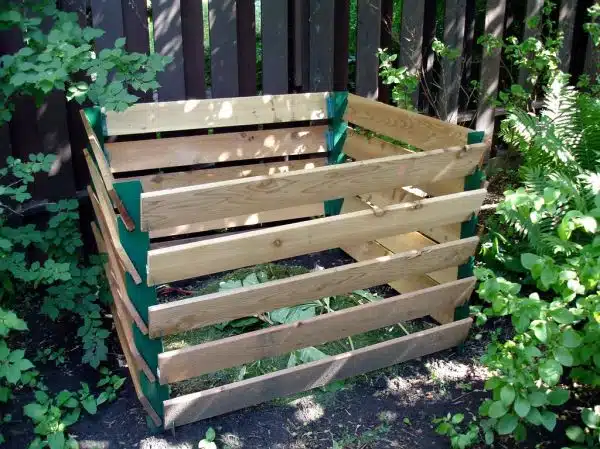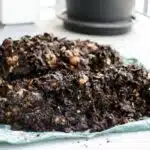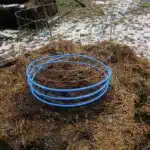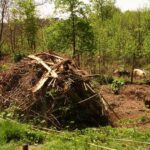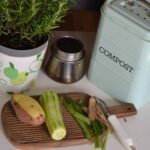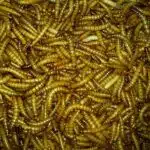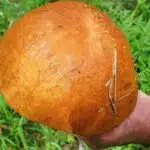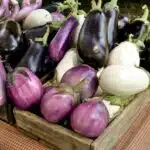Composting is an essential process that converts organic waste into nutrient-rich soil for gardening and farming purposes. Composting is an easy, cost-effective, and eco-friendly way to reduce waste while enhancing the health of your soil. However, many people are unaware of how composting works or how to use compost bins effectively.
In this article, we will explore the science behind composting and its benefits, as well as provide practical tips on how to use compost bins in your home or garden. By understanding the principles of composting and implementing proper techniques, you can transform your kitchen scraps and yard waste into a valuable resource for your plants and the environment. Let’s dive into the world of composting and discover how this simple practice can make a significant impact on our planet.
The Science Of Composting
Composting is a natural process that involves the decomposition of organic matter into a nutrient-rich soil amendment. The composting process occurs in stages, beginning with the breakdown of easily decomposable materials, such as leaves and grass clippings. These materials provide a source of energy for microorganisms, which break them down into simpler compounds.
As the decomposition process continues, more complex organic materials, such as wood chips and paper products, are broken down by fungi and bacteria. These microorganisms release carbon dioxide and other gases as they consume the organic matter. Over time, the heat generated by these biological processes can raise the temperature inside a compost bin to over 140 degrees Fahrenheit.
The final stage of the composting process involves the formation of humus, a dark, nutrient-rich substance that is an excellent soil conditioner. Humus helps to improve soil structure by increasing its ability to hold water and nutrients. It also provides a source of food for beneficial soil organisms like earthworms and beneficial bacteria. Composting is an essential practice that not only reduces waste but also promotes healthy plant growth and improves soil quality.
The Benefits Of Composting
Like a magical alchemist, composting can transform waste into gold for your garden. The benefits of composting are numerous and essential for creating a sustainable and healthy environment. By reducing waste and improving soil health, composting is an effective way to reduce your environmental footprint while also providing a nutrient-rich soil amendment.
- Reducing waste: Composting diverts organic matter from landfills, where it would otherwise release methane gas, which is a potent greenhouse gas that contributes to climate change. Instead, the waste is transformed into a valuable resource that returns nutrients back to the soil.
- Improving soil health: Compost enhances soil fertility by increasing its ability to hold water and nutrients. It also improves the structure of the soil, making it easier for plant roots to grow and access those nutrients.
As a compost bin expert, I have seen firsthand how composting can turn any backyard into an oasis of lush vegetation. Not only does it benefit your garden or farm, but it also helps reduce our overall impact on the planet. By diverting organic materials from landfills and transforming them into nutrient-rich soil amendments instead of contributing to greenhouse gas emissions, we are taking steps towards creating a more sustainable future.
Incorporating composting into your daily life can be as simple as setting aside food scraps or yard waste in a designated container. But the benefits go beyond just reducing waste; they can help create healthier soils that produce healthier plants. Next in line, we will explore the different types of materials you can use for successful composting – each with their own unique properties and benefits.
Types Of Composting Materials
- Organic materials such as vegetable peels, egg shells, coffee grounds and nut shells are ideal for composting and breakdown rapidly, forming a nutrient-rich soil additive.
- Kitchen scraps such as fruit and vegetable peelings, tea bags, egg shells and coffee grounds can be composted in a compost bin.
- Yard waste such as grass clippings, pine needles, leaves, brush and twigs can be mixed with organic materials for composting.
- All organic materials should be mixed in a compost bin for optimal decomposition.
- Compost bins should have equal parts of green and brown materials for a balanced compost.
- To get the most out of composting, mix the organic materials in the compost bin regularly to aerate the pile and ensure proper decomposition.
Organic Materials
Organic materials are an essential component of composting. They include anything that was once alive, such as leaves, grass clippings, vegetable and fruit scraps, eggshells, coffee grounds, and tea bags. Composting with pets can be challenging since their waste should not be included in the compost bin. However, pet hair and fur can be added as they break down quickly and add nitrogen to the pile.
Composting in winter can also be a bit tricky since colder temperatures slow down the decomposition process. It is best to use smaller pieces of organic material during this time and ensure proper aeration by turning the pile regularly. Adding shredded newspaper or cardboard can help generate heat in the bin while maintaining a good balance of carbon and nitrogen.
Remember to avoid adding meat, dairy products, or oily foods to your compost bin as they attract pests and rodents. With proper care and attention to organic materials, your compost pile will transform into nutrient-rich soil that will benefit your garden tremendously. Happy composting!
Kitchen Scraps
As a compost bin expert, I highly recommend incorporating kitchen scraps into your composting materials. Kitchen scraps refer to the food waste generated from cooking and preparing meals in the kitchen. These scraps are rich in nitrogen and can significantly boost the decomposition process of your compost pile.
By adding kitchen scraps to your compost bin, you are reducing waste and contributing to food sustainability. Instead of throwing away food waste, you are transforming it into nutrient-rich soil that can be used to grow healthy plants and vegetables. This not only benefits your garden but also reduces the amount of waste that ends up in landfills.
Some common kitchen scraps that can be added to your compost bin include vegetable and fruit peels, eggshells, coffee grounds, tea bags, and even stale bread. However, it is important to avoid adding meat or dairy products as they attract pests and rodents. With proper care and attention to organic materials such as kitchen scraps, you can create high-quality compost for your garden while also helping the environment.
Yard Waste
A crucial aspect of composting is identifying the right materials to include in your compost pile. As a compost bin expert, I highly recommend utilizing yard waste as one of your primary sources of organic material. Yard waste refers to debris from your lawn and garden, such as grass clippings, leaves, and branches. Incorporating yard waste into your composting materials can significantly benefit your garden while also promoting sustainable yard waste management.
Adding yard waste to your compost pile provides numerous benefits. Firstly, it enhances the nutrient content of the soil by providing essential minerals and elements necessary for plant growth. Secondly, using yard waste in composting reduces the amount of organic matter that ends up in landfills, which supports environmental sustainability. Lastly, incorporating yard waste into your compost pile encourages healthy microbial activity that aids in breaking down other organic materials faster.
When using yard waste as a source of organic material for your compost pile, it is essential to take proper care in its preparation. Avoid adding diseased or infested plant material that could transmit pathogens to the rest of the garden. Also, ensure that any sticks or branches are broken down into smaller pieces before adding them to the compost bin as they take longer to decompose than other materials. By paying attention to these details and combining them with kitchen scraps and other organic materials, you can create high-quality compost for your garden while reducing landfill waste through efficient yard waste management.
Choosing The Right Compost Bin
When choosing the right compost bin, it is important to consider the materials used in its construction. Compost bins are typically made from either plastic, wood, or metal. Plastic bins tend to be the most affordable and lightweight option, but they may not last as long as other materials. Wood bins provide a natural aesthetic and can blend easily into outdoor surroundings, but they require regular maintenance to prevent rotting. Metal bins offer durability and strength, but they can be more expensive and susceptible to rusting.
Another factor to consider when choosing a compost bin is its size. The ideal size for a compost bin depends on the amount of waste generated by your household. Small households may only need a bin that is approximately 1 cubic yard in size, while larger households may require a bin that is closer to 3 cubic yards in size. It is important to choose a bin that will fit comfortably within your available space while still providing enough room for the composting process to occur.
When deciding on the best compost bin for your needs, it is important to weigh the pros and cons of different materials and sizes. Consider factors such as cost, durability, aesthetics, and functionality when making your decision. By choosing the right compost bin for your household and lifestyle, you can create nutrient-rich soil for use in gardening while reducing waste sent to landfills.
As you move forward with setting up your own composting system at home, it’s important to keep in mind that proper set-up will play an essential role in achieving successful results with minimal effort. With the right tools at hand and commitment towards learning soil building techniques through composting, anyone can achieve success with this rewarding hobby.
Setting Up Your Compost Bin
After choosing the right compost bin for your needs, the next step is to decide on its location. Your compost bin should be placed in a spot that is convenient for adding materials but also out of direct sunlight and strong winds. Ideally, it should be located on bare soil or grass to allow for proper drainage and access to beneficial organisms in the soil. Avoid placing your bin near trees or large shrubs as their roots can interfere with the composting process.
The size of your compost bin will depend on how much organic waste you generate and how much space you have available. A small bin may be sufficient if you only have a small garden or produce minimal kitchen waste, while a larger bin may be necessary if you have a larger garden or generate more waste. Keep in mind that a larger bin will require more materials to fill and may take longer to decompose. Whatever size you choose, make sure it has enough ventilation to allow air flow through the materials.
To help get started with your composting journey, consider these benefits of using a compost bin:
- Reduce waste: Composting diverts organic material from landfills and reduces greenhouse gas emissions.
- Improve soil health: Compost adds nutrients to soil, improves soil structure and water retention, and supports beneficial microbial activity.
- Save money: Composting at home can reduce the need for fertilizers and other gardening products.
By choosing an appropriate location and size for your compost bin, you can set yourself up for success in creating nutrient-rich compost for your garden. In the next section, we will discuss how to properly add materials to your compost bin to ensure efficient decomposition.
Adding Materials To Your Compost Bin
One of the most common concerns when it comes to adding materials to your compost bin is whether you are using the right mix of green and brown materials. Green materials, such as fruit and vegetable scraps, provide nitrogen while brown materials, such as leaves and twigs, provide carbon. It’s important to maintain a balance between these two types of materials for optimal decomposition.
When adding green and brown materials to your compost bin, it’s important to keep in mind the size of your bin. A good rule of thumb is to add no more than 25% green materials at a time to prevent overwhelming the system. In addition, chop up larger pieces of material into smaller pieces to speed up the decomposition process.
By adding a variety of green and brown materials in appropriate quantities and sizes, you can create an ideal environment for decomposers like bacteria and worms that break down organic matter into nutrient-rich soil. This not only benefits your garden but also reduces waste going into landfills. In the next section, we will discuss how to further balance your compost pile for optimal results.
Balancing Your Compost Pile
Now that you have added the appropriate materials to your compost bin, it is important to balance the carbon to nitrogen ratio in your pile. A balanced ratio will speed up the decomposition process and result in a nutrient-rich compost. The ideal ratio is 30:1, meaning 30 parts of carbon to 1 part of nitrogen. Carbon-rich materials include dry leaves, wood chips, and shredded paper. Nitrogen-rich materials include fresh grass clippings, fruit and vegetable scraps, and coffee grounds.
To ensure a balanced ratio, layer carbon-rich and nitrogen-rich materials in your bin. Avoid adding too much of one type of material at once as this can create an imbalance and slow down the decomposition process. Additionally, it is important to turn your compost pile regularly for optimal results. Turning frequency depends on several factors including temperature and moisture levels but as a general rule, aim to turn your pile every two weeks.
By balancing your compost pile’s carbon to nitrogen ratio and turning it regularly, you can create a healthy environment for microorganisms to break down organic matter into compost. However, maintaining your compost bin requires more than just balancing ratios and turning the pile. In the next section, we will discuss other key factors such as moisture levels and pest control to ensure long-term success with your composting efforts.
Maintaining Your Compost Bin
Did you know that approximately 25% of household waste can be composted? In fact, the United States Environmental Protection Agency (EPA) reports that food scraps and yard waste make up almost a third of what we throw away. That’s why it’s crucial to maintain your compost bin properly, so you can reduce your environmental impact and create nutrient-rich soil for your garden.
Odor control is an essential aspect of maintaining your compost bin. The decomposition process can produce unpleasant smells if not managed correctly. To avoid this, try incorporating less wet materials into the bin or adding more dry materials like leaves or straw. Additionally, covering the top of the bin with a lid or tarp can help contain odors.
Another important technique in maintaining your compost bin is mastering the turning technique. Turning refers to mixing the contents of the bin together to promote even decomposition and airflow. This helps prevent clumping and matting, which can lead to an overabundance of anaerobic bacteria and slow down the entire process. Use a pitchfork or shovel to turn your compost every week or two, making sure to mix in any new materials you add.
Remember these tips when maintaining your compost bin:
- Keep a good balance of wet and dry materials
- Cover the top of the bin with a lid or tarp
- Turn your compost regularly
- Monitor moisture levels
In summary, maintaining a healthy compost bin requires proper odor control techniques and regular turning practices. By following these guidelines, you’ll be able to produce nutrient-rich soil for your garden while reducing landfill waste. However, sometimes issues may arise during the composting process that require troubleshooting; let’s discuss some common problems in our next section.
Troubleshooting Common Composting Problems
Solving odor issues is one of the most common problems when it comes to composting. The smell can be unpleasant and overwhelming, especially during hot summer months. To combat this issue, make sure you are not adding too much nitrogen-rich materials like meat, dairy, and oily foods. These items can create a putrid odor, attracting unwanted pests like flies and rodents. Instead, focus on adding more carbon-rich materials like leaves, straw, and cardboard to balance out the compost pile.
Another common issue is slow decomposition. If your compost pile seems to be taking longer than usual to decompose, there may be a lack of moisture or airflow. Make sure to turn the pile frequently for optimal oxygen circulation and add water if necessary. Additionally, shredding larger pieces of organic material before adding them to the pile can speed up decomposition.
In summary, troubleshooting common composting problems requires attention to detail in balancing materials and providing optimal conditions for decomposition. By avoiding excess nitrogen-rich materials that cause odor issues and ensuring proper moisture levels and airflow for efficient decomposition, you can effectively maintain a healthy compost pile. In the next section, we will discuss the rewarding process of harvesting and using your finished compost for all your gardening needs.
Harvesting And Using Your Compost
Once your compost has reached maturity, it is time to harvest it for use in your garden. The process of harvesting compost is simple and can be done using a few basic tools. Begin by removing any large materials that have not yet broken down, such as branches or twigs. Next, use a pitchfork to gently turn over the compost heap, breaking up any clumps and exposing any unfinished material.
Once you have sifted through the compost and removed any large materials, you are left with nutrient-rich soil that can be used in a variety of ways. Some common uses for compost include adding it to the soil when planting new plants or vegetables, spreading it around existing plants to provide additional nutrients, and using it to improve the quality of soil in raised beds or container gardens. Compost can also be used as a natural fertilizer for lawns and other outdoor spaces.
Composting is not only a great way to reduce waste and create healthy soil, but it can also be a fun activity to do with children. Involving kids in the process teaches them about environmental responsibility and helps them develop an appreciation for nature. To get started, encourage children to help add food scraps and other organic materials to the compost bin, turning the pile occasionally so they can see how their efforts are helping to break down the waste into usable soil. You can even use the finished product together as a family project by planting seeds or starting a garden together.
As you become more experienced with traditional composting methods, you may want to explore other options such as vermicomposting – which involves using worms to break down organic materials into fertilizer – or experimenting with different types of ingredients in your compost heap. Whatever route you choose, remember that every effort counts towards creating healthier soils and reducing waste in our environment. So grab your pitchforks and start making some “black gold” today!
Composting With Worms: Vermicomposting
After harvesting and using your compost, you may want to consider stepping up your game by incorporating worms into the process. This is known as vermicomposting and it involves selecting the right type of worms to work with. There are a number of different worm species that can be used for vermicomposting, but the most common one is the red wiggler.
When selecting worms for vermicomposting, it’s important to choose a species that is suited to the conditions of your compost bin. Red wigglers are ideal because they thrive in moist, nutrient-rich environments and can consume large quantities of organic matter. Other factors to consider when choosing worms include their reproductive rate and tolerance for different environmental conditions.
Once you have selected your worms, it’s time to set up your composting system. The placement of your bin is an important consideration because you want to create an environment that is conducive to worm activity without disrupting other areas of your yard or garden. A shaded spot with easy access to water and shelter from extreme temperatures is ideal. You should also ensure that the bin has adequate drainage and ventilation to facilitate air flow and prevent moisture buildup.
| Worm Selection | Bin Placement |
|---|---|
| Choose a species suited to bin conditions | Place in a shaded area with access to water |
| Consider reproductive rate and environmental tolerance | Ensure adequate drainage and ventilation |
| Red wigglers are ideal for moist, nutrient-rich environments | Shelter from extreme temperatures |
Incorporating worms into your composting routine can be a rewarding experience that yields rich organic fertilizer for your plants. By selecting the right species of worm and creating an optimal environment within your compost bin, you can enjoy all the benefits of vermicomposting while minimizing any negative impacts on surrounding areas. In our next section, we will explore how you can continue composting even if you live in a small space such as an apartment or condo.
Composting In Small Spaces
Composting is a wonderful way to reduce waste and create nutrient-rich soil for gardening. However, many people who live in small spaces, such as apartments or condos, may feel like they cannot participate in composting. But fear not! Apartment composting is possible, and with the right techniques, anyone can turn their kitchen scraps into beautiful compost.
One option for apartment composting is balcony gardening. If you have a balcony or even just a sunny windowsill, you can grow your own herbs and vegetables in containers. By using your own compost as fertilizer, you will create a closed-loop system that reduces waste while producing fresh produce. Additionally, balcony gardening has been shown to improve mental health and overall well-being.
Another option for small-space composting is vermicomposting. This method uses worms to break down organic matter into nutrient-rich soil. You can keep a worm bin indoors or outdoors and feed them kitchen scraps such as fruit peels and coffee grounds. The worms will eat the scraps and create castings (worm poop) which make excellent fertilizer for plants.
Composting for urban dwellers may seem daunting at first, but it is entirely possible with some creativity and ingenuity. Whether you choose balcony gardening or vermicomposting (or both!), you can reduce your carbon footprint while reaping the benefits of fresh produce and nutrient-rich soil. So get started today and see how easy it can be to compost in small spaces!
Composting For Urban Dwellers
Composting in Small Spaces can be an ideal solution for those who live in apartments, as it allows them to turn their food scraps into rich fertilizer without taking up too much space. However, even if you don’t have a yard or garden, you can still compost effectively by using a compost bin on your balcony. The key is to select a container that is the right size for your space and that has enough ventilation to encourage the decomposition process.
When it comes to Apartment Composting, there are several options available. Some people choose to use worm bins, which are particularly popular for small spaces because they are compact and easy to maintain. Others prefer to use traditional compost bins that can be placed on the balcony or patio. In either case, it’s important to ensure that the bin has adequate drainage and access to oxygen so that the organic material can break down efficiently.
Composting in Balconies also involves some considerations when it comes to choosing the right materials. It’s best to avoid meat and dairy products, as these can attract pests and create unpleasant odors. Instead, stick with fruit and vegetable scraps, coffee grounds, tea bags, eggshells, and shredded newspaper or cardboard. If you’re unsure about what materials are suitable for your compost bin, check with your local gardening center or extension office for guidance. With a little effort and some basic knowledge of composting principles, anyone can turn their apartment balcony into a thriving source of nutrient-rich soil amendment for their plants.
To make Composting a community effort requires collaboration among individuals within neighborhoods or communities who share common goals regarding waste reduction and sustainability practices. This approach involves bringing together individuals who are interested in reducing waste through composting while providing opportunities for learning from one another. Community Composting programs facilitate this collaboration by providing resources such as training sessions on how to build and maintain compost bins along with educational workshops on sustainable living practices. By working together towards common goals, individuals can make a significant impact on reducing waste and promoting sustainability in their communities.
Making Composting A Community Effort
Community involvement is a key factor in successful composting. When a community comes together to compost, it becomes easier for everyone to participate and make the effort worthwhile. By having more people involved, there is a greater chance of success and less waste going to landfills.
One way to get communities involved in composting is by organizing composting events. These events can be as simple as setting up a table at a local farmers market or hosting a workshop on how to start composting. The goal of these events is to educate the community and encourage them to start their own compost bins.
Composting events also provide an opportunity for individuals to connect with others who share their passion for sustainability. This can lead to long-term partnerships between neighbors, schools, and local businesses that work together on larger-scale projects such as community gardens or food waste reduction initiatives. Through community involvement in composting, we can create a cleaner environment and build stronger communities that care about each other’s well-being.
By involving the community in composting efforts, we are taking an important step towards creating a sustainable future. As individuals, we have the power to make small changes that can have significant impacts on our environment and future generations. With more people participating in composting activities, we reduce greenhouse gas emissions from landfills, conserve natural resources, and create healthier soil for growing plants. Together, we can create a better world for ourselves and those who come after us by making composting part of our daily lives.
Composting For A Sustainable Future
Composting is an essential component of sustainable living. It provides a natural way to recycle organic waste and turn it into nutrient-rich soil. Community composting is becoming increasingly popular, as it allows individuals to work together to reduce waste while creating a valuable resource for their gardens or farms. Schools can also benefit from composting programs, as they provide an opportunity for students to learn about the environment and sustainability.
Community composting involves a group of individuals working together to create compost from their organic waste. This type of composting can take many forms, from small backyard bins to larger scale operations that serve entire neighborhoods. By pooling resources and knowledge, community composters can create high-quality soil amendments while reducing the amount of waste sent to landfills. Additionally, these programs often foster a sense of community and shared responsibility for the environment.
Schools are another great place to implement composting programs. Not only do they provide an opportunity for students to learn about environmental science and sustainability, but they also offer a chance for hands-on learning experiences. Composting in schools can take many forms, from classroom vermicomposting bins to larger outdoor systems that involve the whole school community. These programs teach students about the importance of reducing waste and give them practical skills that they can use throughout their lives.
Composting is an important part of any sustainable future. Community composting and school-based programs offer unique opportunities for individuals to come together and make a positive impact on the environment. By working together, we can create healthier soils, reduce greenhouse gas emissions, and build stronger communities that prioritize sustainability.
Conclusion
Composting is an essential process that transforms organic waste into a nutrient-rich material for gardening and farming. Understanding the science of composting, types of composting materials, and selecting the right compost bin are crucial to successful composting. There are various techniques to compost in small spaces, urban areas, and even as a community effort. By engaging in composting practices, we contribute to sustainable living by reducing waste and enhancing the soil’s health.
Did you know that 30% of household waste can be composted? According to the Environmental Protection Agency, this percentage represents food scraps, yard trimmings, and other organic matter that would otherwise end up in landfills or incinerators. This figure highlights the need for individuals and communities to embrace composting as a way of reducing their carbon footprint. As a compost bin expert, I encourage everyone to learn about the benefits of composting and take action towards building a sustainable future for generations to come.
Image Credits
- “Compost Bin” by daryl_mitchell (featured)

